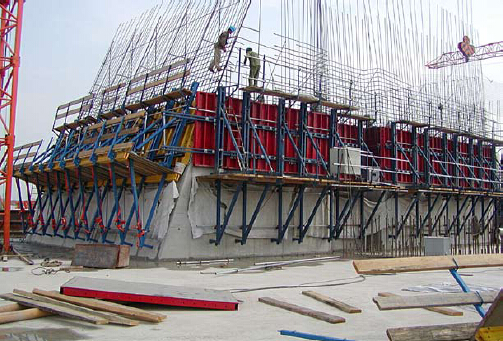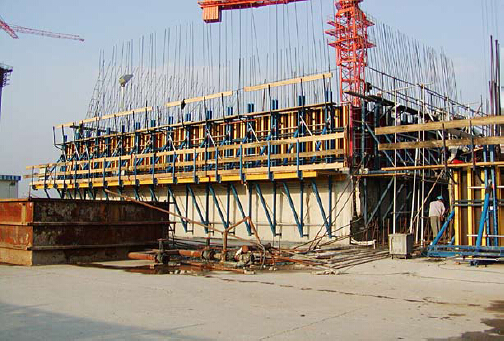Single-side Climbing Bracket SCB-180 for formwork and scaffolding systems
- Loading Port:
- Tianjin
- Payment Terms:
- TT OR LC
- Min Order Qty:
- 50 m²
- Supply Capability:
- 1000 m²/month
OKorder Service Pledge
OKorder Financial Service
You Might Also Like
Single-side Climbing Bracket SCB180:
With CNBM SCB 180 climbing systems, the loads from the fresh concrete pressure are transferred through the brackets by means of V-strongbacks and compression braces into the scaffold anchors.
Typical applications for the SCB 180 are dams, locks, cooling towers, pier heads, tunnels, and bank vaults.
The formwork is simply tilted backwards when striking takes place. The 1.80 m wide bracket requires only a minimum of space.
Characteristics:
◆ Economical and safe anchoring
The M30/D20 climbing cones have been designed especially for single-sided concreting using
SCB180 in dam construction, and to allow the transfer of high tensile and shear forces into the still
fresh, unreinforced concrete. Without wall-through tie-rods, finished concrete is perfect.
◆ Stable and cost-effective for high loads
generous bracket spacings allow large-area formwork units with optimal utilization of the bearing
capacity. This leads to extremely economical solutions.
◆ Simple and flexible planning
With SCB180 single-sided climbing formwork, circular structures can also be concreted without
undergoing any large planning process. Even use on inclined walls is feasible without any special
measures because additional concrete loads or lifting forces can be safely transferred into the
structure.


- Q:What are the different types of formwork release agents used with steel formwork?
- Steel formwork can be used with various types of formwork release agents. These agents are applied to the formwork surface before pouring concrete to prevent sticking and ease removal after curing. A commonly used formwork release agent for steel formwork is petroleum-based. It consists of petroleum oils and additives, creating a thin lubricating film on the formwork surface. This film reduces friction between the formwork and concrete, facilitating damage-free formwork removal. Another option for steel formwork is water-based release agent. It contains water, surfactants, and additives, forming a barrier between the formwork and concrete to prevent adhesion. Water-based agents are preferred when environmental concerns or safety considerations make petroleum-based agents less suitable. Apart from petroleum-based and water-based agents, there are specialty formwork release agents available for steel formwork. These agents may be tailored for specific applications or performance requirements. For instance, high-performance release agents are designed to offer superior release in challenging conditions like high temperatures or humidity. Additionally, there are agents specifically formulated for use with certain concrete types, such as self-consolidating or high-strength concrete. Ultimately, selecting the appropriate formwork release agent for steel formwork depends on project requirements, environmental factors, and personal preferences. Careful selection and correct application of the release agent are crucial for successful formwork removal and achieving the desired concrete finish.
- Q:How does steel formwork perform in seismic zones?
- Steel formwork performs well in seismic zones due to its high strength and durability. Steel is known for its excellent load-bearing capacity and resistance to bending and shearing forces, making it suitable for withstanding the intense shaking and vibrations caused by earthquakes. In seismic zones, the ground experiences significant movement during an earthquake, which can put immense pressure on the formwork system. Steel formwork, being rigid and robust, is able to withstand these forces without any significant deformation or damage. This ensures the stability and integrity of the structure during and after the seismic event. Additionally, steel formwork offers flexibility in design and construction, allowing for the creation of reinforced concrete structures that are better equipped to handle seismic loads. The use of steel formwork enables the incorporation of additional reinforcement elements, such as steel bars and mesh, which enhance the overall strength and ductility of the structure. This helps in dissipating the energy generated by seismic forces and reducing the risk of structural failure. Moreover, steel formwork is reusable and can be easily dismantled and reassembled, making it a cost-effective and sustainable choice for construction in seismic zones. This flexibility allows for the quick repair and reconstruction of structures in the event of earthquake damage, minimizing downtime and ensuring the safety of occupants. Overall, steel formwork is a reliable and resilient choice for construction in seismic zones. Its strength, durability, and flexibility make it well-suited to withstand the forces generated by earthquakes, ensuring the safety and stability of structures in these high-risk areas.
- Q:How does steel formwork ensure accurate concrete dimensions and alignment?
- Steel formwork ensures accurate concrete dimensions and alignment by providing a rigid and stable structure that holds the concrete in place during the pouring and curing process. The steel formwork is designed and fabricated to precise specifications, allowing for precise shaping and positioning of the concrete. The use of steel formwork also reduces the risk of deformation or shifting during the concrete setting, ensuring that the final dimensions and alignment of the concrete structure are maintained.
- Q:Can steel formwork be used for both interior and exterior concrete finishes?
- Yes, steel formwork can be used for both interior and exterior concrete finishes. Its durability and strength make it suitable for various construction projects, providing a smooth and uniform surface finish for both indoor and outdoor applications.
- Q:Can steel formwork be used for curved or non-standard concrete shapes?
- Indeed, curved or non-standard concrete shapes can be achieved using steel formwork. The versatility of steel as a material allows for its effortless manipulation into various forms. This quality makes it particularly suitable for creating concrete structures with unique and intricate designs. Unlike traditional wooden formwork, steel formwork can be easily bent, twisted, or shaped to accommodate any desired curvature or non-standard shape. Furthermore, steel formwork offers exceptional strength and durability, ensuring its ability to withstand the immense pressure exerted by the concrete during pouring and curing. Consequently, steel formwork is widely employed in construction projects necessitating curved or non-standard concrete shapes, including architectural features, decorative elements, and complex structural components.
- Q:How does steel formwork affect the overall construction cost?
- Steel formwork can have a significant impact on the overall construction cost. While the initial cost of steel formwork may be higher compared to other types of formwork such as timber or aluminum, it provides numerous advantages that can lead to cost savings in the long run. Firstly, steel formwork is extremely durable and has a longer lifespan compared to other materials. This means that it can be reused multiple times, reducing the need for new formwork on future projects. As a result, the cost of purchasing or renting formwork for subsequent projects is reduced, leading to overall cost savings. Additionally, steel formwork is known for its high strength and stability. This allows for faster construction processes as it can withstand higher concrete pressures, resulting in faster cycle times. The ability to achieve faster construction speeds can reduce labor costs and shorten the overall construction timeline, resulting in cost savings. Moreover, steel formwork provides excellent quality and precision in concrete structures. It allows for accurate shaping and forming of concrete elements, resulting in better finishes and fewer defects. This can reduce the need for additional finishing work, repairs, or rework, leading to cost savings in terms of material and labor. Furthermore, steel formwork can also improve safety on construction sites. Its stability and strength can withstand adverse weather conditions and prevent accidents. By ensuring a safe working environment, potential delays and costs associated with accidents or injury can be minimized. Lastly, steel formwork is known for its versatility and adaptability. It can be easily customized to suit various project requirements, allowing for flexibility in design and construction. This versatility can result in optimized construction processes and materials, ultimately reducing costs. In conclusion, while the initial cost of steel formwork may be higher, its durability, strength, speed, accuracy, safety, and versatility can lead to significant cost savings in terms of reusability, labor, materials, and time. Therefore, steel formwork positively affects the overall construction cost by providing long-term value and efficiency.
- Q:What are the different types of formwork ties used in steel formwork?
- Some of the different types of formwork ties used in steel formwork include snap ties, wedge ties, coil ties, and flat ties. These ties are used to secure the formwork panels together and provide stability during the concrete pouring process.
- Q:Can steel formwork be used for both straight and curved concrete walls?
- Yes, steel formwork can be used for both straight and curved concrete walls. Steel formwork is versatile and can be easily bent and adjusted to create curved walls of various shapes and sizes. It provides strong support and stability, allowing for the construction of both straight and curved walls with precision and accuracy. Additionally, steel formwork is durable and reusable, making it a cost-effective option for projects that require both straight and curved concrete walls.
- Q:How is steel formwork adjusted for different concrete thicknesses?
- Steel formwork can be adjusted for different concrete thicknesses by using adjustable formwork systems. These systems typically include adjustable props, beams, and panels that can be configured and secured to accommodate varying concrete depths. The props can be extended or shortened to provide the necessary height, while the beams and panels can be adjusted and connected to ensure a tight fit around the concrete structure. This flexibility allows the steel formwork to be easily adapted to different concrete thicknesses during construction.
- Q:Can steel formwork be used for fire-resistant concrete structures?
- Fire-resistant concrete structures can indeed utilize steel formwork. Steel possesses exceptional strength and heat resistance, rendering it an optimal choice for constructing formwork in such cases. Furthermore, steel formwork presents several benefits, including longevity, reusability, and effortless assembly and disassembly. By offering essential support and containment during the pouring and curing processes, it guarantees the integrity and safety of the structure in the event of a fire. Nevertheless, it is crucial to acknowledge that the fire resistance of the concrete itself is contingent upon factors like mix design, aggregate selection, and thickness, rather than relying solely on the formwork material.
1. Manufacturer Overview |
|
|---|---|
| Location | |
| Year Established | |
| Annual Output Value | |
| Main Markets | |
| Company Certifications | |
2. Manufacturer Certificates |
|
|---|---|
| a) Certification Name | |
| Range | |
| Reference | |
| Validity Period | |
3. Manufacturer Capability |
|
|---|---|
| a)Trade Capacity | |
| Nearest Port | |
| Export Percentage | |
| No.of Employees in Trade Department | |
| Language Spoken: | |
| b)Factory Information | |
| Factory Size: | |
| No. of Production Lines | |
| Contract Manufacturing | |
| Product Price Range | |
Send your message to us
Single-side Climbing Bracket SCB-180 for formwork and scaffolding systems
- Loading Port:
- Tianjin
- Payment Terms:
- TT OR LC
- Min Order Qty:
- 50 m²
- Supply Capability:
- 1000 m²/month
OKorder Service Pledge
OKorder Financial Service
Similar products
New products
Hot products
























